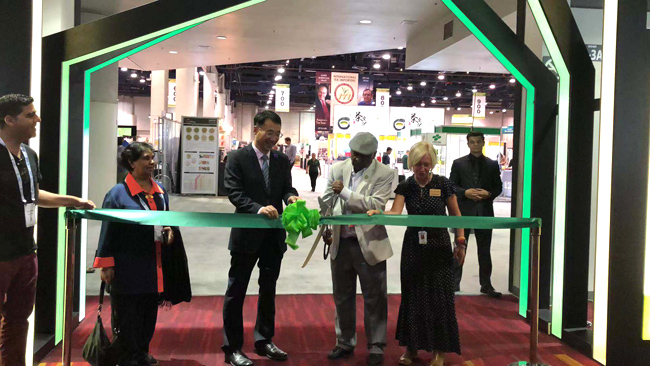Thank you for taking an interest in the work underway at ISTA. 2019 has been a busy year for our organization. We would like to update you on all that has happened and what we have planned for the future.
Zheng Guojian visits the USA
Secretary Zheng Guojian is the director of the China National Center of Tea Quality Supervision and Inspection of Tea at the Hangzhou Tea Research Institute (China COOP). Secretary Zheng visited the United States and consulted with ISTA as part of the continuing partnership between the organizations.
The importance of this visit can not be overstated. ISTA enjoys a strong relationship with all three of China’s national-level tea institutes but this is the first time that the leader in one of the tea research institutes visited the United States. Of the three institutes, Hangzhou TRI China COOP interacts with the tea industry most directly. Hangzhou TRI China COOP is responsible for national standards for the Chinese tea industry and participates in setting ISO standards.
Secretary Zheng first met with ISTA board members in Tucson, Arizona and then attended the The World Tea Expo held in Las Vegas, Nevada. The constraints on travel time of government officials made the trip brief, but our time together offered significant insights. Secretary Zheng was able to observe the tea industry in North America, noting at once North American’s capacity for appreciation of high-end tea, but also the difficulty for firms and consumers in the continent to buy and import high-end tea. Both sides were convinced that increased access to Chinese tea and information exchange with the expertise of the Chinese industry are necessary for sustained global growth of specialty tea.

ISTA Workshops Chinese Tea Evaluation Methods with Teas from Global Origins
In May this year, ISTA conducted workshops of Chinese standard protocols for tea evaluation.
As we work to develop calibrated evaluation and scoring methods to suit specialty tea on an international scale, the Chinese approach to evaluation and scoring of tea is a natural touchstone for ISTA’s research. China is home to the largest specialty tea industry in the world and has developed its own evaluation and scoring methods to suit its industry.
The workshops took place with the help of a panel of tea professionals as well researchers from outside of the tea industry, namely Dr. Rena Shifren of Prosense Laboratories and food science and nutrition faculty of the University of Arizona.
Panelists evaluated teas from China, Japan, Korea, India, and Nepal. Samples were selected to represent a range of international teas in broadly similar style (e.g. “green tea” “black tea” etc) and were roughly pre-judged by an experienced tea buyer to be of “commercially viable” quality. The goal of this selection was to test how the protocols could differentiate levels of quality within this very general pool.
To our satisfaction, the experienced buyers within the panel felt that the teas ranked appropriately. Equally as promising was that tea-inexperienced tasters also scored teas within reasonable calibration the tea professionals. For example, Dr. Shifren participated as a taster with no prior experience in tea. We should note, though, that Dr. Shifen comes from an academic and professional background with thirty years of experience in sensory evaluation, including a certification from UC Davis in wine evaluation. Dr. Shifen had no previous experience with the protocols and guidelines we presented to her and there were no guides for individual styles of tea used for these workshops. Nevertheless Dr. Shifen’s scoring of the teas were in-line with the experienced tasters.
These results leads us to believe that even sensory evaluation can have a scientific approach, that is one that can be measured and calibrated in a way that moves it further away from subjectivity and biases of individual tasters. A learnable and objective process can be more universally accepted. With its development, groups of evaluators from across the world will be able to have a cohesive definition for specialty and quality within tea.
As you can imagine, this development and implementation is a lot of work. Even after five years of research ourselves, it is easy to say that we are just scratching the surface.
Work Underway
The work of ISTA board members and advisors is currently focused on the development of three major documents:
1. Evaluation and scoring protocols
ISTA currently has a working draft, but it needs to be further workshopped for clarity, precision and efficacy. There are many considerations involved in substantiating these protocols with improved practices from current sensory and food science. Tea industry cupping methods have only loosely addressed this, even in China. It is also necessary to determine where processes can be simplified. One sticking point is that the Chinese evaluation system requires calibration samples. This poses some difficulty if it is to be integrated into a broad system, at least when starting out, because a standard calibration sample is not available anywhere. We are working on plans to collect and verify samples, but that is going to take time and money. A system will have to be developed that so that we can collect these samples efficiently each season.
2. Style guides
These style guides will provide reference points for use when evaluating prominent teas (e.g. Longjong, First Flush Darjeeling, Gyokuro, Dahongpao etc.) Compiling these guides requires input from authorities at origin, specifically tea makers, to assure that they accurately inform evaluators throughout the world. This is expected to require some time spent on the ground in origin countries and a detailed on-going correspondence with advisors there.
3. A lexicon of terms to inform the use of the above documents
This is especially necessary for sensory evaluation. While important work has already been done to develop flavor wheels and lexicons in the tea industry, there are yet some difficulties here that need to be overcome if a lexicon can operate with both breadth and utility. For example, the Chinese evaluation system has an official lexicon that is so large and varied that is unwieldy even for trained tasters. This lexicon is also problematic in that it also includes many terms that are embedded in cultural context such that they would be usable by Chinese tasters but would not be easily recognizable to panel of international tasters. Additionally, many lexicons lack a scientific basis for the terms they included or references for these terms. These are significant wrinkles to iron out and will require many rounds of input, testing, and revision.
This is a lot of work ahead. It would be completely daunting if we were trying to judge all the tea in the world. Fortunately, we are not. We are judging the skill of the tea maker. A way to consider this simply is to define the baseline of skillfully made tea as the absence of defects. Of course judging what a tea maker has done well is part of it, but through sensory evaluation, tasters can identify defects and understand how they relate to the tea making process. The process of making tea is difficult, and although the number of processes are few, it is really hard to get then all to come out right. Understanding common defects and identifying their presence or absence in tea will be an integral part of the documents listed above. It is a means to simply and depart from the completely subjective.
The overall goal of this work is to provide a means to which tasters throughout the world can be taught and calibrated in their scoring. Ideally, standards for calibrated scoring will provide a roadmap for tea buyers, both commercial and consumers, and also gives tea makers feedback on their tea making abilities. This can be accomplished in a broad-based, standardized, and accessible way so that tea evaluation is not a matter of individual taste, popularity, or brewing skills.
Where You Can Help
The work ahead is significant and currently our biggest issue is fundraising. ISTA operates with an all-volunteer staff and its directors have invested tens of thousands of dollars so far in getting to this point. The scope of what we are doing is no longer within our means. We are looking for grant writers, people that understand crowdsourcing, and people with non-profit organizational experience. If you have these skills and would like to help ISTA, please contact us. We want membership to stay free until we make major progress on the tasks at hand but, in the meantime, individuals can also help by contributing direct donations on our website. Donations are 100% tax deductible as ISTA is a 501 (C) (3) nonprofit organization.

